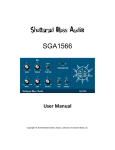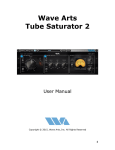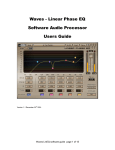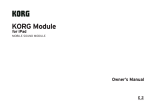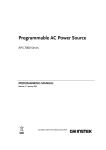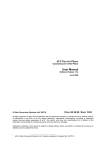Download SGA1566 MkII User Manual
Transcript
Shattered Glass Audio SGA1566 MKII User Manual Copyright © 2014 Shattered Glass Audio, a division of Creative Bytes, Inc. Introduction .................................................................................................................................................. 3 Signal Routing ............................................................................................................................................... 3 SGA1566 MKII Circuit .................................................................................................................................... 4 Equalizer.................................................................................................................................................... 4 Preamplifier .............................................................................................................................................. 5 Technology .................................................................................................................................................... 5 Circuit Simulation ...................................................................................................................................... 6 Hybrid Model ............................................................................................................................................ 6 Using SGA1566 MKII ..................................................................................................................................... 6 System Requirements ................................................................................................................................... 7 Mac ........................................................................................................................................................... 7 Windows ................................................................................................................................................... 7 Controls ......................................................................................................................................................... 7 Input .......................................................................................................................................................... 7 Gain ........................................................................................................................................................... 7 Output ....................................................................................................................................................... 7 EQ Controls ............................................................................................................................................... 7 Bass ....................................................................................................................................................... 7 Treble .................................................................................................................................................... 7 Position ................................................................................................................................................. 7 Oversampling ............................................................................................................................................ 8 Factor .................................................................................................................................................... 8 Type....................................................................................................................................................... 8 CPU ............................................................................................................................................................ 8 Stereo ........................................................................................................................................................ 8 Presets........................................................................................................................................................... 8 Product Unlocking ......................................................................................................................................... 9 Tips .............................................................................................................................................................. 10 2 Introduction SGA1566 MkII is loosely based on a single channel vintage tube preamplifier with added two-band active Baxandall EQ and stereo processing. To achieve the most authentic analog sound, the whole preamp circuit is simulated in real time using the high performance circuit simulator. This level of sound fidelity comes at a price of high CPU utilization. For cases where such a CPU hit is prohibitive, we have added two additional modes of operation that are less CPU intensive. The two-band Baxandall EQ can be positioned either before or after the preamp, or be completely taken out of the signal chain. Up to 8x oversampling can be used to eliminate aliasing. SGA1566 MkII offers two different filter types for use in oversampling. Use SGA1566 MKII preamp to add warmth to a track, as a saturation compressor, or to add “dirt” with tube overdrive. Features: - Authentic analog sound through real-time high-performance circuit simulation. Preamp featuring two 12AX7 voltage amplification stages. CPU friendly model of the circuit. Two-band active Baxandall EQ that can be taken out of the signal path or placed either before or after the preamp. Up to 8x oversampling with two choices of filtering. Mono or stereo processing mode. Signal Routing There are three possible signal paths in SGA1566 MKII. Figure 1. Shows the signal path with the EQ bypassed. Upsampling In Preamplifier Input Gain Downsampling and DC Block Out Output Gain Figure 1. Signal routing without EQ in the signal path. Figure 2 shows signal routing with the EQ before the preamplifier. The signal first passes through the 2band active Baxandall EQ. Input Gain block adjusts the strength of the signal going into the preamplifier. Output Gain adjusts the signal level leaving the plugin. This configuration can, depending on the signal strength, affect the level of overdrive that different frequencies experience because the tonal shaping happens before the preamplifier stage. 3 In 2-band EQ Upsampling Preamplifier Downsampling and DC Block Input Gain Out Output Gain Figure 2. Signal routing with the EQ before the preamplifier. Figure 3 shows signal routing with the EQ after the preamplifier. Input Gain adjusts the signal strength entering the preamplifier. After the preamplifier the signal passes through the 2-band active Baxandall EQ. Output Gain adjusts strength of the signal leaving the plugin. Placing the EQ after the preamplifier allows for post amplification tonal shaping. Upsampling In Downsampling and DC Block Preamplifier 2-band EQ Input Gain Out Output Gain Figure 3. Signal routing with the EQ after the preamplifier For computational efficiency only the preamplifier processes oversampled signal. The reason being is that the preamplifier is the only non-linear element in the signal chain, therefore the only element capable of creating additional harmonic content. SGA1566 MKII Circuit SGA1566 MKII uses a two stage triode preamplifier and a 2-band active Baxandall EQ for tonal manipulation. Equalizer The circuit schematic of the 2-band active Baxandall EQ is shown in Figure 4. 50n 11k 100k 11k EQ In Bass 11k 5n + Treble 3.6k Ideal opamp 500k Figure 4. Two band active Baxandall equalizer. 4 3.6k EQ Out The circuit is derived from the article “Designing A Pocket Equalizer For Headphone Listening” by Chu Moy (http://headwize.com/?page_id=741). Bass threshold frequency is approximately 300 Hz and the bass shelf frequency is approximately 30Hz. Treble threshold frequency is approximately 1 kHz whereas treble shelf frequency is approximately 10 kHz. Maximum gain and reduction of the circuit are +20dB and -20dB respectively. Preamplifier The circuit schematic of the preamplifier is shown in Figure 5. 155V 0.15 µ 100 k 100 k Gain Inpu t 12AX7 Output 100 k 12AX7 33 k 1M 1200 1200 50 µ Figure 5. Schematic of the preamplifier circuit. The preamp in SGA1566 MKII is a two stage triode based amplifier. Each amplification stage is a 12AX7 based common cathode amplifier. Common cathode configuration is commonly used in (pre)amplifiers to amplify a weak signal to levels needed to drive a power amplifier. There are couple of interesting things to note about this circuit: - - Supply voltage is 155V, which is substantially lower than the usual 200V+ voltage supply. The lower supply voltage translates into less clean headroom thereby making this preamp easy to overdrive. Gain potentiometer is 100kΩ, which is of the same order as the output impedance of the first stage. A consequence of this is the reduced gain of the first stage. Usually this potentiometer would have a value of 1MΩ so it does not affect the gain of the first stage. Technology Depending on the mode of operation SGA1566 MKII uses either: 5 a) Real time circuit simulation to simulate the preamplifier. b) Slightly less accurate hybrid model (combining elements of the circuit simulation with standard DSP elements) for the preamplifier simulation. Two-band active Baxandall EQ circuit is represented with an equivalent DSP filter structure, for efficiency reasons. Circuit Simulation Analog-circuit simulators, the most well-known of which is SPICE, have been in use by engineers for decades. At the most basic level, circuit simulators take the circuit schematic, input signals, and simulation parameters as inputs and return voltages and optionally currents as outputs. To do that, circuit simulators turn the schematic into a set of differential equations that needs to be solved at each time step during transient analysis. If the circuit contains non-linear components (e.g. vacuum tubes, transistors, etc.) resulting set of non-linear differential equations needs to be solved iteratively at each time step during transient analysis. The circuit simulation provides the most accurate simulation of analog circuits at the expense of heavy CPU usage. At the heart of the SGA1566 MKII circuit simulation is the Shattered Glass Audio’s high-performance circuit simulator. We, at Shattered Glass Audio, have created a circuit simulator using the same principles that SPICE is built on and optimized it for real time analysis. As a result of using circuit simulation to simulate the preamp, SGA1566 MKII delivers sound that possesses the genuine analog warmth associated with the vintage tube amplifiers. Hybrid Model Hybrid model was developed as a substitute for the circuit simulation in cases where the high CPU usage is unacceptable or where the real time circuit simulation is outright impossible. The hybrid model of the preamp combines elements of the circuit simulation with standard DSP elements. Such preamp model is significantly less computationally intensive than the circuit simulation of the preamp alone. The computational efficiency of the hybrid model comes at the price of a slightly reduced accuracy when compared to the circuit simulation, at the same sampling frequency. The difference between the two simulation modes is the most audible when the preamp is distorting the sound dominated by frequencies higher than approx. 5kHz. The accuracy of the hybrid model can be improved by increasing the sample rate or through the use of oversampling. Using SGA1566 MKII At low input signal levels and low Gain settings, SGA1566 MKII preamplifier simulates a clean tube preamp. When operated in such conditions SGA1566 MKII can be used to enrich the original sound by adding “warmth” (additional harmonics) to it. The effect of adding warmth to the original sound is a direct consequence of the nonlinear nature of vacuum tubes. 6 At higher signal strengths and/or higher Gain settings SGA1566 MKII simulates an overdriven tube preamp. A characteristic of overdriving a vacuum tube is soft clipping. Because of the soft clipping when driven into overdrive, SGA1566 MKII can be used as a saturation compressor/limiter. System Requirements This plugin is available in both 32- and 64-bit VST and AU versions. AU version is available for Mac only. Mac OS X 10.8 or higher. Windows 7/8. Controls Settings controlled by knobs can be changed by clicking on them and dragging the mouse up and down. Settings controlled by switches can be changed by clicking on the appropriate switch or by clicking a switch and dragging the mouse. Input Controls the strength of the input signal to the preamplifier. Gain This control corresponds to the “Gain” potentiometer in Figure 5. Gain controls the signal level at the input to the second preamplifier stage. Output This control lets you adjust the output level of the whole plugin. EQ Controls Bass Sets the EQ bass level. Values less than 5 correspond to bass cut, whereas values greater than 5 correspond to bass boost. Value of 5 corresponds to neither cut nor boost. Treble Sets the EQ treble level. Values less than 5 correspond to treble cut, whereas values greater than 5 correspond to treble boost. Value of 5 corresponds to neither cut nor boost. Position Sets the position of the EQ in the signal path or takes it out of the signal path. To take the EQ out of the signal path set the switch to OFF. To place the EQ before the preamp, as shown in Figure 2, set this switch to PRE. To place the EQ after the preamp, as shown in Figure 3, set this switch to POST. 7 Oversampling Factor Select 1, 2, 4, or 8 times the original sampling rate. When oversampling is set to 1x no oversampling is performed (i.e. the plugin operates at the original sampling frequency). Type Select the type of filter used for oversampling. When this control is set to “A” linear phase filter is used for oversampling. To use maximally flat filter for oversampling choose the “B” setting. As implemented in SGA1566 MkII: choosing the linear phase filter, the A option, results in a linear phase response and a sharper cutoff at half the sampling frequency. choosing the B option results in virtually no delay (only a few samples). CPU CPU control allows you to control the CPU utilization by selecting different types/parameters of the circuit simulation. The HIGH and MID settings select the full circuit simulation, whereas the LOW setting selects the hybrid circuit simulation model. Difference between the HIGH and the MID settings is the maximum number of iterations allowed for the preamp circuit simulation. The HIGH setting allows the higher number of iterations than the MID setting. This results in up to, approximately, 30% higher CPU utilization on the “HIGH” setting when compared to the “MID” setting. The higher number of iterations on the “HIGH” setting also makes the “HIGH” CPU setting more accurate than the “MID” setting. By virtue of selecting the hybrid circuit simulation model, the LOW setting is the easiest on the CPU but also the least accurate of the three. Stereo Stereo control lets you switch between mono and stereo processing. To set processing to mono, set the STEREO switch to OFF. Stereo processing nearly doubles the CPU load of the plug-in when compared to mono processing since in the stereo mode the plug-in needs to process two channels compared to one channel in the mono mode. Presets Two buttons at the bottom of the SGA1566 MkII window control loading and saving of presets. The longer button is used is used for loading of presets and to display the current presets name. To load presets click on the presets name button at the bottom of the window and select the file that contains the settings you want to load. To save current settings, click on the Save button at the bottom of the window. In the file dialog enter the file name you want to save current settings to. 8 Product Unlocking Unlocking your product is easy. To unlock the product you will need the license file sent to you in an email at the time of purchase. If you did not receive the license file you can have it resent to you by going to the support at www.shatteredglassaudio.com. You should save the license file at a location on your file system accessible to the product. When you run the product for the first time, after installation, you will be presented with the dialog shown in Figure 6. Click the “Unlock with the License File” button and select the license key file. Figure 6. Product unlocking dialog. If there are no errors importing the license key, SGA1566 MkII’s user interface will replace the product unlocking dialog. 9 Tips To find the product version and to whom it is licensed, hover the mouse over the Shattered Glass Audio logo on the bottom of the product window. The following are tips for minimizing the CPU usage: Set the STEREO control to OFF if you are processing a mono track. Setting the STEREO control to OFF will half the CPU load. This is necessary since not all DAWs accurately, or at all, report whether a track is mono or stereo. Use the least amount of oversampling needed to avoid aliasing. Consider using the MID or LOW CPU mode. 10










